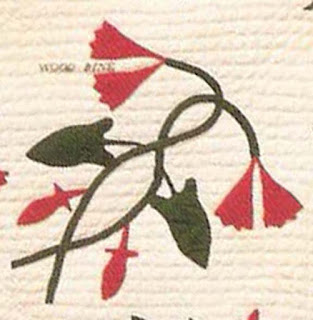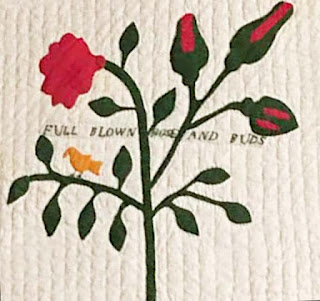"Wood Bine," the name embroidered or inked on a botanical
sampler in the collection of the Shelburne Museum.
The plant looks like what we out here in Kansas call Bindweed,
Convolvulus, an unwelcome guest in the garden.
This one's easier to identify:
"Full Blown Rose & Buds"
Like Esther Blair Matthews's Shenandoah Valley quilt this sampler has common
plant names inscribed on the blocks. It's in the collection of the Shelburne
Museum and probably dates, like most appliqued red & green samplers,
to about 1840-1870. The museum believes it to be from Pennsylvania.
"Poke Berries"
They know little about it but it does seem to indicate a strong link to the scrapbook herbariums, an extraordinary quilt. And what is even more extraordinary:
There are others very much like it.
Collector Carolyn Miller owns this sampler with a sawtooth border.
Some of the same blocks; wreaths cut for the edges.
Except Carolyn's doesn't have the plant names.
It has the same plain final border. Carolyn's is quilted
with a cable of six lines (a weak clue to a Pennsylvania origin?)...
While the Shelburne's has a feather and wreath motif in
the quilting. In both the blocks are quilted in parallel lines.
Other similarities include the sets: blocks placed side by side
on point with no sashing.
The set helps identify this one as a different quilt.
Same blocks but set with sashing and the blocks are quilted in a grid.
I found the detail photo floating around the internet.
And here's a fourth example, from auctioneers Pook & Pook.
Very much like the Shelburne's with a single plain white border...
So much like the Shelburne's that if you superimpose
one on the other they are almost identical.
No embroidered plant identifications though.
So here we have four very similar quilts.
How?
1) A teacher shared this pattern with her botanizing students.
2) Someone drew the pattern and shared it by selling it or giving it away.
3) Or one person made all four.
And here's a fifth, a top with a double sawtooth border in
Donna Stickovich's collection.
This one includes other blocks, the blocks are sashed and set
on the straight.
Here are the Wood Bine and Poke Berries blocks, not so
skillfully done as the other examples.
But she obviously had a similar source.
And this is a recent addition to the file, from the Montana project
and their book. Green sash. Nothing known.
The picture may just be a portion of the whole quilt.
All six include the Wood Bine
All six the Hop Vine
Hop vine
But only four have the Laurel.
Mountain Laurel
All very inspiring.
And that's the end of the Botanizing here.
























I'm a gardener and an antique quilt fan. Thanks so very much for these 5 articles.
ReplyDeleteI'm a gardener and an antique quilt fan. Thanks so very much for these 5 articles.
ReplyDeleteI do love these botanizing quilts - beautiful. Thank you.
ReplyDeleteThe whole series has been interesting and inspiring. Thank you for putting it together and sharing. This is my favorite of the posts, partly because the quilts are so beautiful and partly because of the mystery of them being so alike.
ReplyDeleteThank you so much for this series. This post with the comparisons is wonderful.
ReplyDeleteWhat beautiful work on those quilts, amazing.
ReplyDeleteTo start and then finish quilts like that took tenacity.
Wow very interesting. love the work in research you do. lovely posts everytime. Poke berries, I'd call those choke cherries.
ReplyDelete